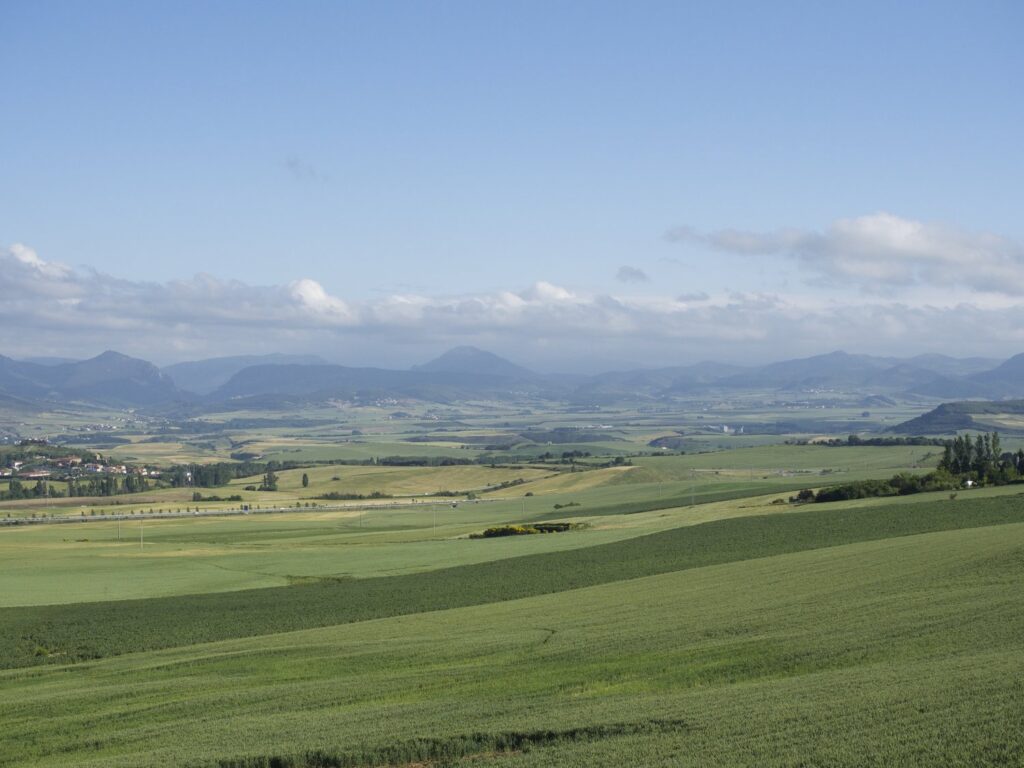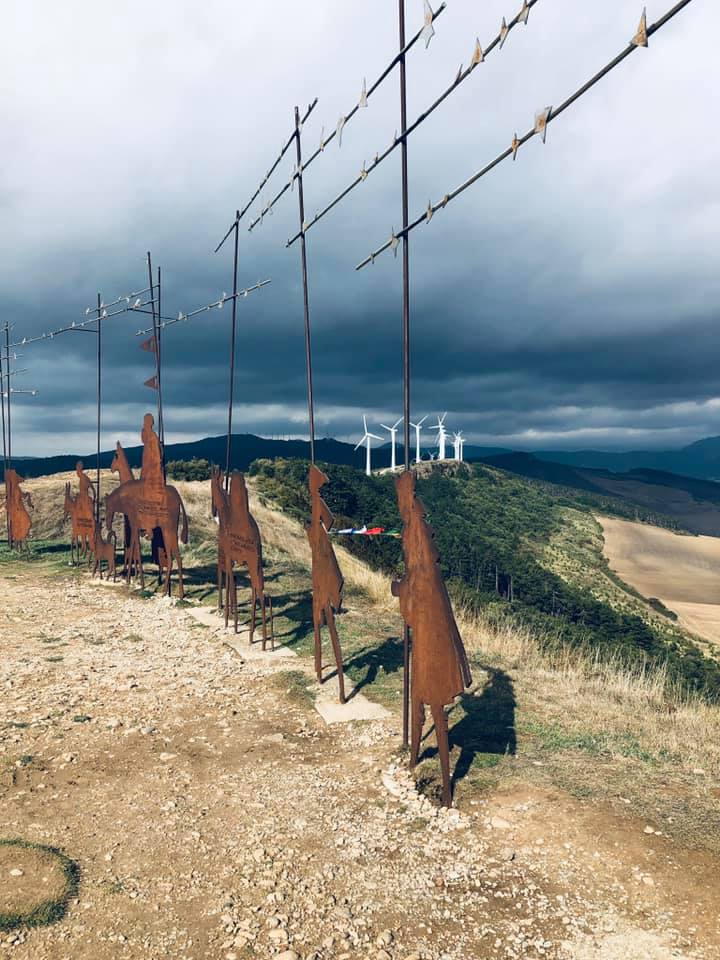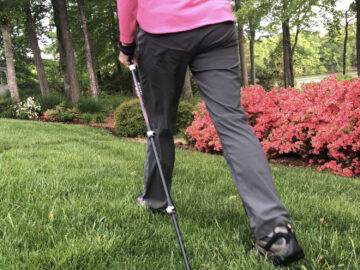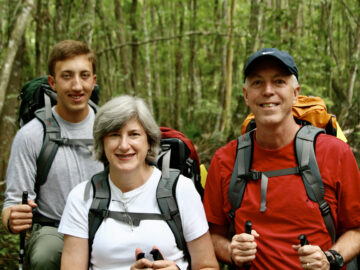The Alto de Perdón (Hill of Forgiveness) is an iconic Camino location, and a tough climb just past Pamplona. A centuries old pilgrim tradition is still in use today. Pilgrims forgive others, and ask forgiveness for themselves, with each step up the hill. Choosing the path of forgiveness is life-giving.

The Meaning Behind the Sculpture
I found some of the story behind the sculpture of the pilgrim procession. It's in an excerpt from a book titled The Lore of the Camino de Santiago, by Jean Mitchell-Lanham. She writes,
The sculpture exhibits a small history of pilgrims and the pilgrimage…through various stages of development. Beginning in the Middle Ages up to the present day, in the form of a procession. The first pilgrim appears to be searching for the route and symbolizes the beginning of interest in the pilgrimage. Next is a group of three that depicts the growth or rise in popularity of the Camino.
These three are followed by another group depicted as merchants or tradesmen on horseback. This symbolizes the medieval era of merchants hawking their wares to the pilgrims. Spaced away from them is a solitary figure that characterizes the decline in pilgrimages. This was due to political, religious, and social unrests from the mid-fourteenth to the mid-twentieth centuries. At the very end of the procession are two modern-day figures. They are depicted to show the renewed interest and rise in popularity of the pilgrimage in the late twentieth century.
Jean Mitchell-Lanham, The Lore of the Camino de Santiago
The Hill of Forgiveness Is Personal to Each Pilgrim
Three Experiences of the Hill
by Fr. Hunter Van Wagenen I have climbed the Alto de Perdón on three of my Caminos. As I reflect on each of those times I see a stark contrast and varying beauty of those three days.
My First Time Up The Hill
It was 2007 when I first walked the Camino. The Alto de Perdón remains one of the most striking visual memories. The day was clear and a fine autumn breeze was blowing. The farmers had harvested their wheat, so the soil was bare and upturned. The sky was a vivid blue, and the Pyrenees to the east, so distant yet defined in the sunlight. As I made my ascent, a glance back took my breath away and brought a tear to my eye. In short, it was so beautiful. I met no one else that whole day. But I took everything, from the beauty of the landscape to the individual sunflowers I passed, as a gift.
Second Time
The second time I walked, in 2011, I started my journey in Pamplona via Barcelona. I flew into Barcelona and took an overnight bus. This seemed more economical than a bed at a hostel in the city. I wanted to get to Pamplona first thing in the morning and get my pilgrim credenciál. The only problem with that plan was that the bus arrived at 4:30am. Nothing was open yet, not even a café. Instead of waiting around out in the cold, I set out for the next town. I was operating on just a few hours of light sleep. Therefore, I don’t remember much of the ascent up the Hill. However, on the descent it was incredible to watch the sun rise. The dawn began to light up the distant landscape once it spilled over the Hill to light up the path. It was majestic.

My Third Time Up the Hill
The third time, in June-July 2013, I was with friends. A few approached the Camino as a chance to do some food and drink tourism. I became frustrated with them for that. It was also my first (and probably last) time wearing sandals to walk. That is to say, unlike the previous two times, the weather was very wet; in fact, the path leading up the Hill had turned into a dangerous stretch of slippery mud.
Those of us with hiking poles and more strength were able to make it up. However, many of the older pilgrims struggled. The experience was miserable physically. I got huge blisters from the mud in my sandals. But, I remember it for an amazing display of pilgrim camaraderie. Several of us younger, stronger pilgrims laid our packs at the top of the Hill. After that, we were able to go back down to help those who were struggling. We held their hands, carried their packs, and guided them through the less slippery parts. It was a beautiful moment of community and fellowship.

Preparing for The Hill
Just Past Pamplona
Pamplona is the first large city on the Camino for peregrinos (pilgrims) who start in St. Jean Pied-de-Port. Thrill-seeking pilgrims might want to explore the city as the famed site of the annual running of the bulls. Moreover, most will still be adjusting to pilgrim life, and nursing their first blisters. However, just past Pamplona is a difficult climb. The Alto de Perdón challenges every pilgrim physically and spiritually.

Above all, the landscape west of Pamplona is gorgeous when the sun is shining. Rolling hills and fields give beautiful texture and color to the ground. Depending on the time of year it might be golden with wheat, or a rich red from upturned soil. The edges of the Pyrenees create a sense of scale. The sky seems huge, and you feel small.
Flowers and bramble cover the Alto de Perdón, giving it a sense of charm and wonder. On the ridge of the Hill is the captivating metal sculpture of a pilgrim procession, and wind turbines slowly circling. But the real meaning of the place comes from the difficulties that pilgrims face as they climb. In medieval times pilgrims started a tradition. As they walk the winding path they pray to forgive those who have hurt them. In addition, they pray to receive forgiveness for the hurts and wrongs they themselves have committed.

Lay Down What Weighs Down Your Heart
On the Hill, one of the beautiful images of the Camino comes to the fore – that of bearing burdens. For example, what wrongs have you committed that weigh on your heart, mind, or soul? Who have you hurt? What hurts have you received but not forgiven? What grudge or grievance are you holding onto?
Drinking Poison Expecting the Other Person to Die
These things weigh us down. Moreover, they are deadly. Carrying bitterness or unforgiveness towards another person is like drinking poison, expecting the other person to die. Holding a grudge is like grasping a hot coal and expecting it to burn the other person. I think these sayings are true. Walking the Camino allows us to perform the difficult task of letting go of what weighs on us. Choosing forgiveness, is the first part. Dealing with what comes next can take time.
Lay Down Your Pack, Lay Down Your Grudges and Guilt
When we lay down our pack for the day, consider what burdens we carry in our minds or hearts. How can we lay those down as well? The Hill of Forgiveness is an excellent place to put those burdens to rest as you trudge upwards. Notice the strain on your body chip away your resistance to let go of your grudge, blame, and guilt. Consequently, when you reach the summit, exult in the freedom of forgiveness.

Best Time to Forgive Is Now
You don't have to wait to walk up the Alto de Perdón to forgive and ask forgiveness. Practicing forgiveness, and nurturing a heart of forgiveness toward people can begin today.
Do you have a story to share from the Hill of Forgiveness?





